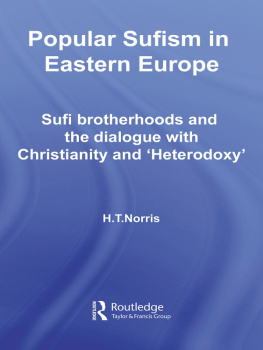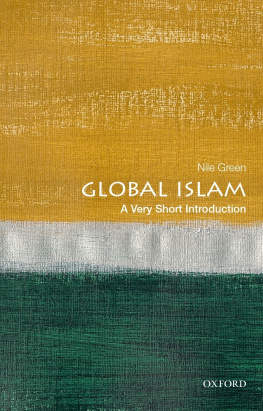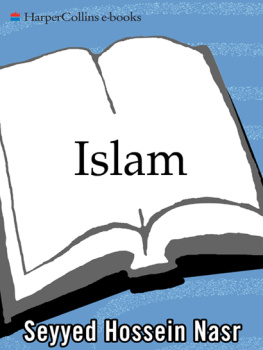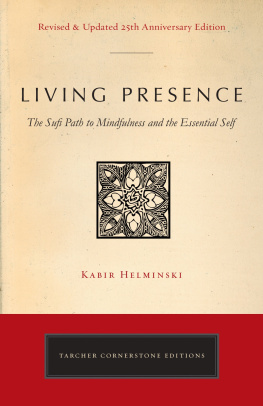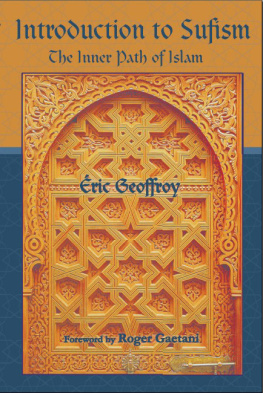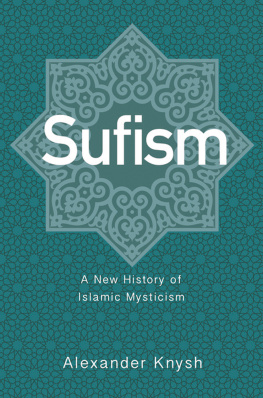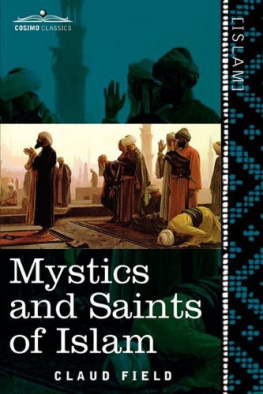
Ibn Arabi, a Sufi for All Ages.
SUFISM
An Introduction to theMystical Tradition of Islam
Carl W. Ernst, PhD

Shambhala
Boulder
2016
Shambhala Publications, Inc.
4720 Walnut Street
Boulder, Colorado 80301
www.shambhala.com
1997 by Carl W. Ernst
This book was previously published as The Shambhala Guide to Sufism.
All rights reserved. No part of this book may be reproduced in any form or by any means, electronic or mechanical, including photocopying, recording, or by any information storage and retrieval system, without permission in writing from the publisher.
Library of Congress Cataloging-in-Publication Data
Ernst, Carl W., 1950
Sufism: an introduction to the mystical tradition of Islam / Carl W. Ernst.
p. cm.
Includes bibliographical references and index.
eISBN 978-0-8348-2297-9
ISBN 978-1-59030-884-4 (pbk.: alk. paper)
1. Sufism. 2. MysticismIslam. I. Title.
BP189.E76 2011
297.4dc22
2010053253
To Annemarie Schimmelwith gratitude and affection
I T IS A PLEASURE to see a new publication of this introduction to Islamic mysticism, which was originally issued as part of a series of guidebooks to different spiritual traditions. Interest in Sufism has continued to grow in America, both among spiritual seekers and scholarly researchers. This phenomenon is noteworthy not only as an index of cultural globalization in the twenty-first century, but also as a form of engagement with Islamicate culture. It is especially noteworthy since it takes place at a time when Islam is commonly treated as an antagonist by sensationalist news media and extremist commentators.
It has been particularly gratifying for me, as a scholar of religious studies, to receive numerous positive responses to this book over the years, from a variety of different readers both in the United States and abroad (including readers of the Spanish, Greek, Italian, and Russian translations). I wrote this book as an exercise in public scholarship, calling upon the best work of university presses, and drawing critical attention to the categories and presuppositions that we bring to the study of Sufismbut without using the overly technical jargon that makes too much academic work seem irrelevant (as I explain in my article, Its Not Just Academic: Writing Public Scholarship in Middle Eastern and Islamic Studies, Review of Middle East Studies [2011]). My goal was to write in a style that would be clear and intelligible to the general reader, but which would also avoid easy generalizations; the aim was to empower readers by presenting critical overviews of the consequences of contested issues, in this way permitting readers to draw their own conclusions. In passing, I have learned that a number of Sufi leaders and quite a few devotees have found this book to be useful. It has also been very rewarding to see that many of my academic colleagues have regularly used this book in their college courses in Islamic studies. Perhaps the reason this book has been able to find a home among such diverse readers is that it illustrates the tension between the outsider and insider approaches to understanding religion, without attempting to flatten out that creative space with authoritative pronouncements. What is offered here does not pretend to be an esoteric revelation. It is a fair-minded overview of the way Sufism has played an important religious, cultural, social, and political role for more than a thousand years, both in its traditional Asian and African homelands and (more recently) in Europe and America. This book also offers, in the opening chapter, what is perhaps the first critical presentation of the way in which Sufism has been imagined as a religious category in the minds of modern Europeans and Americans. It also situates Sufism as a contested subject that is debated today by Muslim fundamentalists, secular modernists, and Orientalists, even while it is defended by Sufi sympathizers.
Inevitably, in the years since this books first publication there have been numerous contributions to the study of Sufism, ranging from translations of important texts to analyses of various themes and topics in the history of Sufism, and serious readers are advised to consult these works. Nevertheless, this book can still serve as a reasonably reliable guide to the lay of the land, illustrating the issues that surround this fascinating subject. I hope that this new edition will provide an opportunity for many more readers to reflect on the rich legacy of Sufism, and to consider its historic and contemporary relevance.
For a discussion of the problems in studying Islam today, see Carl W. Ernst, Following Muhammad: Rethinking Islam in the Contemporary World (Chapel Hill, NC: The University of North Carolina press, 2003), especially the preface and chapter 1. For the term Islamicate, see p. xvii of this book.
).
T EN YEARS AGO, I went to Pakistan on a Fulbright research grant, with the aim of writing a book on South Asian Sufism. It was an extraordinary year, in which my family and I experienced the remarkable hospitality and cultural richness of the people of Lahore. But a peculiar thing happened whenever Pakistani acquaintances questioned me about my work. Sometimes, when informed that I was studying Sufism, the questioner would sit back and observe in a dismissive way, Well, you should know that Sufism has nothing to do with Islam. On other occasions, my interlocutor would lean forward enthusiastically and say something like, Youre working on Sufism! Wonderful! Let me tell you, my grandfather was a pir [master], and I can take you to visit his tomb if you wish. These two attitudes reflect an ambivalence about the term Sufism, and its relation to Islam, that is deeply written into contemporary Muslim societies around the world.
In most Muslim societies today one can find a current of dogmatic piety that is quite critical of many of the practices and beliefs associated with Sufism. This tendency, which has come to the fore mainly since the year 1800, is often described by its followers in terms of the revival or reform of the Islamic faith. In its most ideological and political manifestations, this attitude is best known to the mass media under the term fundamentalism, or Islamism; for those who have had no contact with actual Muslim men and women, the medias politicized concept of Islam is all that there is. Specialists prefer to use the term fundamentalism to describe the ideology of antimodernism that has taken hold among approximately twenty percent of the adherents of all major religious traditions. In this respect, Islamic fundamentalism has a role and strength comparable to Christian, Jewish, Hindu, and Buddhist fundamentalisms. Most observers have been impressed with the way in which fundamentalists have concentrated their wrath on denunciations of the secularism and moral corruption associated with the West, now a code word for the governing political, economic, and scientific authority invested in European and American countries and, to a lesser extent, in their former colonies. Thus to some extent the rhetoric of fundamentalism in Muslim countries is a polemical response to the vast colonial enterprise of conquest carried out by Western countries. In that process, from the time of Napoleons invasion of Egypt in 1793 to the breakup of the Ottoman empire in 1920, nearly every Muslim country was conquered and colonized by foreign powers. So it should not be surprising that resistance to Western dominance continued to be a major theme on the part of ideologues like Irans Ayatollah Khomeini.
Next page

